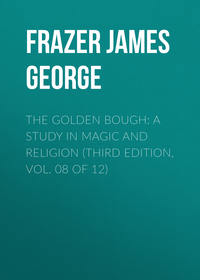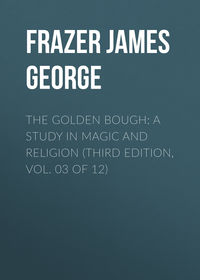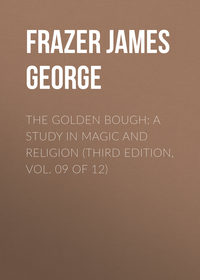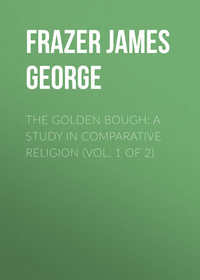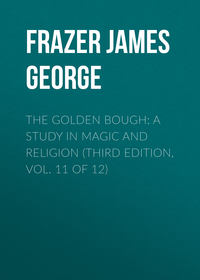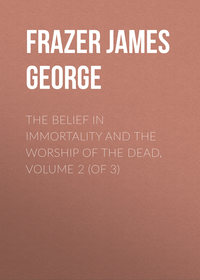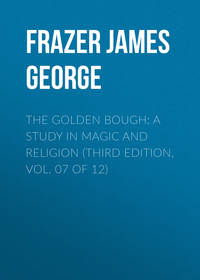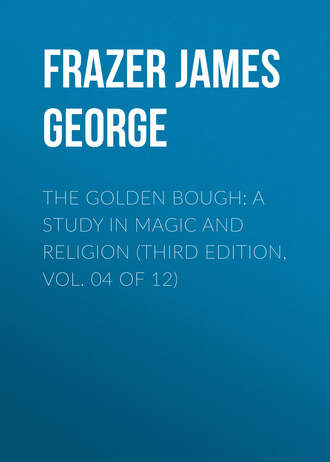 полная версия
полная версияThe Golden Bough: A Study in Magic and Religion (Third Edition, Vol. 04 of 12)
Modern European beliefs as to meteors. Various beliefs as to stars and meteors.
Superstitions of the same sort are still commonly to be met with in Europe. Thus in some parts of Germany they say that at the birth of a man a new star is set in the sky, and that as it burns brilliantly or faintly he grows rich or poor; finally when he dies it drops from the sky in the likeness of a shooting star.152 Similarly in Brittany, Transylvania, Bohemia, the Abruzzi, the Romagna, and the Esthonian island of Oesel it is thought by some that every man has his own particular star in the sky, and that when it falls in the shape of a meteor he expires.153 A like belief is entertained by Polish Jews.154 In Styria they say that when a shooting star is seen a man has just died, or a poor soul been released from purgatory.155 The Esthonians believe that if any one sees a falling star on New Year's night he will die or be visited by a serious illness that year.156 In Belgium and many parts of France the people suppose that a meteor is a soul which has just quitted the body, sometimes that it is specially the soul of an unbaptized infant or of some one who has died without absolution. At sight of it they say that you should cross yourself and pray, or that if you wish for something while the star is falling you will be sure to get it.157 Among the Vosges Mountains in the warm nights of July it is not uncommon to see whole showers of shooting stars. It is generally agreed that these stars are souls, but some difference of opinion exists as to whether they are souls just taking leave of earth, or tortured by the fires of purgatory, or on their passage from purgatory to heaven.158 The last and most cheering of these views is held by the French peasantry of Beauce and Perche and by the Italian peasantry of the Abruzzi, and charitable people pray for the deliverance of a soul at the sight of a falling star.159 The downward direction of its flight might naturally suggest a different goal; and accordingly other people have seen in the transient flame of a meteor the descent of a soul from heaven to be born on earth. In the Punjaub, for example, Hindoos believe that the length of a soul's residence in the realms of bliss is exactly proportioned to the sums which the man distributed in charity during his life; and that when these are exhausted his time in heaven is up, and down he comes.160 In Polynesia a shooting star was held to be the flight of a spirit, and to presage the birth of a great prince.161 The Mandans of north America fancied that the stars were dead people, and that when a woman was brought to bed a star fell from heaven, and entering into her was born as a child.162 On the Biloch frontier of the Punjaub each man is held to have his star, and he may not journey in particular directions when his star is in certain positions. If duty compels him to travel in the forbidden direction, he takes care before setting out to bury his star, or rather a figure of it cut out of cloth, so that it may not see what he is doing.163
The fall of the king's star.
Which, if any, of these superstitions moved the barbarous Dorians of old to depose their kings whenever at a certain season a meteor flamed in the sky, we cannot say. Perhaps they had a vague general notion that its appearance signified the dissatisfaction of the higher powers with the state of the commonwealth; and since in primitive society the king is commonly held responsible for all untoward events, whatever their origin, the natural course was to relieve him of duties which he had proved himself incapable of discharging. But it may be that the idea in the minds of these rude barbarians was more definite. Possibly, like some people in Europe at the present day, they thought that every man had his star in the sky, and that he must die when it fell. The king would be no exception to the rule, and on a certain night of a certain year, at the end of a cycle, it might be customary to watch the sky in order to mark whether the king's star was still in the ascendant or near its setting. The appearance of a meteor on such a night – of a star precipitated from the celestial vault – might prove for the king not merely a symbol but a sentence of death. It might be the warrant for his execution.
Reasons for limiting a king's reign to eight years. The octennial cycle based on an attempt to reconcile solar and lunar time.
If the tenure of the regal office was formerly limited among the Spartans to eight years, we may naturally ask, why was that precise period selected as the measure of a king's reign? The reason is probably to be found in those astronomical considerations which determined the early Greek calendar. The difficulty of reconciling lunar with solar time is one of the standing puzzles which has taxed the ingenuity of men who are emerging from barbarism. Now an octennial cycle is the shortest period at the end of which sun and moon really mark time together after overlapping, so to say, throughout the whole of the interval. Thus, for example, it is only once in every eight years that the full moon coincides with the longest or shortest day; and as this coincidence can be observed with the aid of a simple dial, the observation is naturally one of the first to furnish a base for a calendar which shall bring lunar and solar times into tolerable, though not exact, harmony.164 But in early days the proper adjustment of the calendar is a matter of religious concern, since on it depends a knowledge of the right seasons for propitiating the deities whose favour is indispensable to the welfare of the community.165 No wonder, therefore, that the king, as the chief priest of the state, or as himself a god, should be liable to deposition or death at the end of an astronomical period. When the great luminaries had run their course on high, and were about to renew the heavenly race, it might well be thought that the king should renew his divine energies, or prove them unabated, under pain of making room for a more vigorous successor. In southern India, as we have seen, the king's reign and life terminated with the revolution of the planet Jupiter round the sun. In Greece, on the other hand, the king's fate seems to have hung in the balance at the end of every eight years, ready to fly up and kick the beam as soon as the opposite scale was loaded with a falling star.
The octennial cycle in relation to the Greek doctrine of rebirth.
The same train of thought may explain an ancient Greek custom which appears to have required that a homicide should be banished his country, and do penance for a period of eight or nine years.166 With the beginning of a new cycle or great year, as it was called, it might be thought that all nature was regenerate, all old scores wiped out. According to Pindar, the dead whose guilt had been purged away by an abode of eight years in the nether world were born again on earth in the ninth year as glorious kings, athletes, and sages.167 The doctrine may well be an old popular belief rather than a mere poetical fancy. If so, it would supply a fresh reason for the banishment of a homicide during the years that the angry ghost of his victim might at any moment issue from its prison-house and pounce on him. Once the perturbed spirit had been happily reborn, he might be supposed to forgive, if not to forget, the man who had done him an injury in a former life.
The octennial cycle at Cnossus in Crete. King Minos and Zeus. Sacred marriage of the king and queen of Cnossus in the form of bull and cow as symbols of the sun and moon.
Whatever its origin may have been, the cycle of eight years appears to have coincided with the normal length of the king's reign in other parts of Greece besides Sparta. Thus Minos, king of Cnossus in Crete, whose great palace has been unearthed in recent years, is said to have held office for periods of eight years together. At the end of each period he retired for a season to the oracular cave on Mount Ida, and there communed with his divine father Zeus, giving him an account of his kingship in the years that were past, and receiving from him instructions for his guidance in those which were to come.168 The tradition plainly implies that at the end of every eight years the king's sacred powers needed to be renewed by intercourse with the godhead, and that without such a renewal he would have forfeited his right to the throne. We may surmise that among the solemn ceremonies which marked the beginning or the end of the eight years' cycle the sacred marriage of the king with the queen played an important part, and that in this marriage we have the true explanation of the strange legend of Pasiphae and the bull. It was said that Pasiphae, the wife of King Minos, fell in love with a wondrous white bull which rose from the sea, and that in order to gratify her unnatural passion the artist Daedalus constructed a hollow wooden cow, covered with a cow's hide, in which the love-sick queen was hidden while the bull mounted it. The result of their union was the Minotaur, a monster with the body of a man and the head of a bull, whom the king shut up in the labyrinth, a building full of such winding and intricate passages that the prisoner might roam in it for ever without finding the way out.169 The legend appears to reflect a mythical marriage of the sun and moon, which was acted as a solemn rite by the king and queen of Cnossus, wearing the masks of a bull and cow respectively.170 To a pastoral people a bull is the most natural type of vigorous reproductive energy,171 and as such is a fitting emblem of the sun. Islanders who, like many of the Cretans, see the sun daily rising from the sea, might readily compare him to a white bull issuing from the waves. Indeed, we are expressly told that the Cretans called the sun a bull.172 Similarly in ancient Egypt the sacred bull Mnevis of Heliopolis (the City of the Sun) was deemed an incarnation of the Sun-god,173 and for thousands of years the kings of Egypt delighted to be styled “mighty bull”; many of them inscribed the title on their serekh or cognisance, which set forth their names in their character of descendants of Horus.174 The identification of Pasiphae, “she who shines on all,” with the moon was made long ago by Pausanias, who saw her image along with that of the sun in a sanctuary on that wild rocky coast of Messenia where the great range of Taygetus descends seaward in a long line of naked crags.175 The horns of the waxing or waning moon naturally suggest the resemblance of the luminary to a white cow; hence the ancients represented the goddess of the moon drawn by a team of white cattle.176 When we remember that at the court of Egypt the king and queen figured as god and goddess in solemn masquerades, where the parts of animal-headed deities were played by masked men and women,177 we need have no difficulty in imagining that similar dramas may have been performed at the court of a Cretan king, whether we suppose them to have been imported from Egypt or to have had an independent origin.
The same myth and custom of the marriage of the sun and moon appear in the stories of Zeus and Europa, of Minos and Britomartis. The conjunction of the sun and moon regarded as the best time for marriages. Octennial marriage of the king and queen as representatives of the sun and moon.
The stories of Zeus and Europa, and of Minos and Britomartis or Dictynna appear to be only different expressions of the same myth, different echoes of the same custom. The moon rising from the sea was the fair maiden Europa coming across the heaving billows from the far eastern land of Phoenicia, borne or pursued by her suitor the solar bull. The moon setting in the western waves was the coy Britomartis or Dictynna, who plunged into the sea to escape the warm embrace of her lover Minos, himself the sun. The story how the drowning maiden was drawn up in a fisherman's net may well be, as some have thought, the explanation given by a simple seafaring folk of the moon's reappearance from the sea in the east after she had sunk into it in the west.178 To the mythical fancy of the ancients the moon was a coy or a wanton maiden, who either fled from or pursued the sun every month till the fugitive was overtaken and the lovers enjoyed each other's company at the time when the luminaries are in conjunction, namely, in the interval between the old and the new moon. Hence on the principles of sympathetic magic that interval was considered the time most favourable for human marriages. When the sun and moon are wedded in the sky, men and women should be wedded on earth. And for the same reason the ancients chose the interlunar day for the celebration of the Sacred Marriages of gods and goddesses. Similar beliefs and customs based on them have been noted among other peoples.179 It is likely, therefore, that a king and queen who represented the sun and moon may have been expected to exercise their conjugal rights above all at the time when the moon was thought to rest in the arms of the sun. However that may have been, it would be natural that their union should be consummated with unusual solemnity every eight years, when the two great luminaries, so to say, meet and mark time together once more after diverging from each other more or less throughout the interval. It is true that sun and moon are in conjunction once every month, but every month their conjunction takes place at a different point in the sky, until eight revolving years have brought them together again in the same heavenly bridal chamber where first they met.
Octennial tribute of youths and maidens probably required as a means of renewing the sun's fire by human sacrifices. The Minotaur a bull-headed image of the sun.
Without being unduly rash we may surmise that the tribute of seven youths and seven maidens whom the Athenians were bound to send to Minos every eight years had some connexion with the renewal of the king's power for another octennial cycle. Traditions varied as to the fate which awaited the lads and damsels on their arrival in Crete; but the common view appears to have been that they were shut up in the labyrinth, there to be devoured by the Minotaur, or at least to be imprisoned for life.180 Perhaps they were sacrificed by being roasted alive in a bronze image of a bull, or of a bull-headed man, in order to renew the strength of the king and of the sun, whom he personated. This at all events is suggested by the legend of Talos, a bronze man who clutched people to his breast and leaped with them into the fire, so that they were roasted alive. He is said to have been given by Zeus to Europa, or by Hephaestus to Minos, to guard the island of Crete, which he patrolled thrice daily.181 According to one account he was a bull,182 according to another he was the sun.183 Probably he was identical with the Minotaur, and stripped of his mythical features was nothing but a bronze image of the sun represented as a man with a bull's head. In order to renew the solar fires, human victims may have been sacrificed to the idol by being roasted in its hollow body or placed on its sloping hands and allowed to roll into a pit of fire. It was in the latter fashion that the Carthaginians sacrificed their offspring to Moloch. The children were laid on the hands of a calf-headed image of bronze, from which they slid into a fiery oven, while the people danced to the music of flutes and timbrels to drown the shrieks of the burning victims.184 The resemblance which the Cretan traditions bear to the Carthaginian practice suggests that the worship associated with the names of Minos and the Minotaur may have been powerfully influenced by that of a Semitic Baal.185 In the tradition of Phalaris, tyrant of Agrigentum, and his brazen bull186 we may have an echo of similar rites in Sicily, where the Carthaginian power struck deep roots.
Dance of the youths and maidens at Cnossus.
But perhaps the youths and maidens who were sent across the sea to Cnossus had to perform certain religious duties before they were cast into the fiery furnace. The same cunning artist Daedalus who planned the labyrinth and contrived the wooden cow for Pasiphae was said to have made a dance for Ariadne, daughter of Minos. It represented youths and maidens dancing in ranks, the youths armed with golden swords, the maidens crowned with garlands.187 Moreover, when Theseus landed with Ariadne in Delos on his return from Crete, he and the young companions whom he had rescued from the Minotaur are said to have danced a mazy dance in imitation of the intricate windings of the labyrinth; on account of its sinuous turns the dance was called “the Crane.”188 Taken together, these two traditions suggest that the youths and maidens who were sent to Cnossus had to dance in the labyrinth before they were sacrificed to the bull-headed image. At all events there are good grounds for thinking that there was a famous dance which the ancients regularly associated with the Cretan labyrinth.
The game of Troy.
Among the Romans that dance appears to have been known from the earliest times by the name of Troy or the Game of Troy. Tradition ran that it was imported into Italy by Aeneas, who transmitted it through his son Ascanius to the Alban kings, who in their turn handed it down to the Romans. It was performed by bands of armed youths on horseback. Virgil compares their complicated evolutions to the windings of the Cretan labyrinth;189 and that the comparison is more than a mere poetical flourish appears from a drawing on a very ancient Etruscan vase found at Tragliatella. The drawing represents a procession of seven beardless warriors dancing, accompanied by two armed riders on horseback, who are also beardless. An inscription proves that the scene depicted is the Game of Troy; and attached to the procession is a figure of the Cretan labyrinth,190 the pattern of which is well known from coins of Cnossus on which it is often represented.191 The same pattern, identified by an inscription, “Labyrinthus, hic habitat Minotaurus,” is scratched on a wall at Pompeii; and it is also worked in mosaic on the floor of Roman apartments, with the figures of Theseus and the Minotaur in the middle.192 Roman boys appear to have drawn the very same pattern on the ground and to have played a game on it, probably a miniature Game of Troy.193 Labyrinths of similar type occur as decorations on the floors of old churches, where they are known as “the Road of Jerusalem”; they were used for processions. The garden mazes of the Renaissance were modelled on them. Moreover, they are found very commonly in the north of Europe, marked out either by raised bands of turf or by rows of stones. Such labyrinths may be seen in Norway, Sweden, Denmark, Finnland, the south coast of Russian Lappland, and even in Iceland. They go by various names, such as Babylon, Wieland's House, Trojeborg, Tröburg, and so forth, some of which clearly indicate their connexion with the ancient Game of Troy. They are used for children's games.194
The dance at Cnossus perhaps an imitation of the sun's course in the sky.
A dance or game which has thus spread over Europe and survived in a fashion to modern times must have been very popular, and bearing in mind how often with the decay of old faiths the serious rites and pageants of grown people have degenerated into the sports of children, we may reasonably ask whether Ariadne's Dance or the Game of Troy may not have had its origin in religious ritual. The ancients connected it with Cnossus and the Minotaur. Now we have seen reason to hold, with many other scholars, that Cnossus was the seat of a great worship of the sun, and that the Minotaur was a representative or embodiment of the sun-god. May not, then, Ariadne's dance have been an imitation of the sun's course in the sky? and may not its intention have been, by means of sympathetic magic, to aid the great luminary to run his race on high? We have seen that during an eclipse of the sun the Chilcotin Indians walk in a circle, leaning on staves, apparently to assist the labouring orb. In Egypt also the king, who embodied the sun-god, seems to have solemnly walked round the walls of a temple for the sake of helping the sun on his way.195 If there is any truth in this conjecture, it would seem to follow that the sinuous lines of the labyrinth which the dancers followed in their evolutions may have represented the ecliptic, the sun's apparent annual path in the sky. It is some confirmation of this view that on coins of Cnossus the sun or a star appears in the middle of the labyrinth, the place which on other coins is occupied by the Minotaur.196
Conclusions as to the king of Cnossus.
On the whole the foregoing evidence, slight and fragmentary as it is, points to the conclusion that at Cnossus the king represented the sun-god, and that every eight years his divine powers were renewed at a great festival, which comprised, first, the sacrifice of human victims by fire to a bull-headed image of the sun, and, second, the marriage of the king disguised as a bull to the queen disguised as a cow, the two personating respectively the sun and the moon.
Octennial festivals of the Crowning at Delphi and the Laurel-bearing at Thebes. Both represented dramatically the slaying of a water-dragon.
Whatever may be thought of these speculations, we know that many solemn rites were celebrated by the ancient Greeks at intervals of eight years.197 Amongst them, two deserve to be noticed here, because it has been recently suggested, with some appearance of probability, that they were based on an octennial tenure of the kingship.198 One was the Festival of the Crowning at Delphi; the other was the Festival of the Laurel-bearing at Thebes. In their general features the two festivals seem to have resembled each other very closely. Both represented dramatically the slaying of a great water-dragon by a god or hero; in both, the lad who played the part of the victorious god or hero crowned his brows with a wreath of sacred laurel and had to submit to a penance and purification for the slaughter of the beast. At Delphi the legendary slayer of the dragon was Apollo; at Thebes he was Cadmus.199 At both places the legendary penance for the slaughter seems to have been servitude for eight years.200 The evidence for the rites of the Delphic festival is fairly complete, but for the Theban festival it has to be eked out by vase-paintings, which represent Cadmus crowned with laurel preparing to attack the dragon or actually in combat with the monster, while goddesses bend over the champion, holding out wreaths of laurel to him as the mede of victory.201 It is true that in historical times Apollo appears to have ousted Cadmus from the festival, though not from the myth. But at Thebes the god was plainly a late intruder, for his temple lay outside the walls, whereas the most ancient sanctuaries stood in the oldest part of the city, the low hill which took its name of Cadmea from the genuine Theban hero Cadmus.202 It is not impossible that at Delphi also, and perhaps at other places where the same drama was acted,203 Apollo may have displaced an old local hero in the honourable office of dragon-slayer.
Both at Delphi and at Thebes the dragon seems to have guarded the oracular spring and the oracular tree. The crown of laurel and the crown of oak. The Festival of Crowning at Delphi originally identical with the Pythian games.
Both at Thebes and at Delphi the dragon guarded a spring,204 the water of which was probably deemed oracular. At Delphi the sacred spring may have been either Cassotis or the more famed Castaly, which issues from a narrow gorge, shut in by rocky walls of tremendous height, a little to the east of Apollo's temple. The waters of both were thought to be endowed with prophetic power.205 Probably, too, the monster was supposed to keep watch and ward over the sacred laurel, from which the victor in the combat wreathed his brows; for in vase-paintings the Theban dragon appears coiled beside the holy tree,206 and Euripides describes the Delphic dragon as covered by a leafy laurel.207 At all oracular seats of Apollo his priestess drank of the sacred spring and chewed the sacred laurel before she prophesied.208 Thus it would seem that the dragon, which at Delphi is expressly said to have been the guardian of the oracle,209 had in its custody both the instruments of divination, the holy tree and the holy water. We are reminded of the dragon or serpent, slain by Hercules, which guarded the golden apples of the Hesperides in the happy garden.210 But at Delphi the oldest sacred tree appears, as Mr. A. B. Cook has pointed out,211 to have been not a laurel but an oak. For we are told that originally the victors in the Pythian games at Delphi wore crowns of oak leaves, since the laurel had not yet been created.212 Now, like the Festival of Crowning, the Pythian games were instituted to commemorate the slaughter of the dragon;213 like it they were originally held every eighth year;214 the two festivals were celebrated nearly at the same time of the year;215 and the representative of Apollo in the one and the victors in the other were adorned with crowns made from the same sacred laurel.216 In short, the two festivals appear to have been in origin substantially identical; the distinction between them may have arisen when the Delphians decided to hold the Pythian games every fourth, instead of every eighth year.217 We may fairly suppose, therefore, that the leaf-crowned victors in the Pythian games, like the laurel-wreathed boy in the Festival of Crowning, formerly acted the part of the god himself. But if in the beginning these actors in the sacred drama wore wreaths of oak instead of laurel, it seems to follow that the deity whom they personated was the oak-god Zeus rather than the laurel-god Apollo; from which again we may infer that Delphi was a sanctuary of Zeus and the oak before it became the shrine of Apollo and the laurel.218




